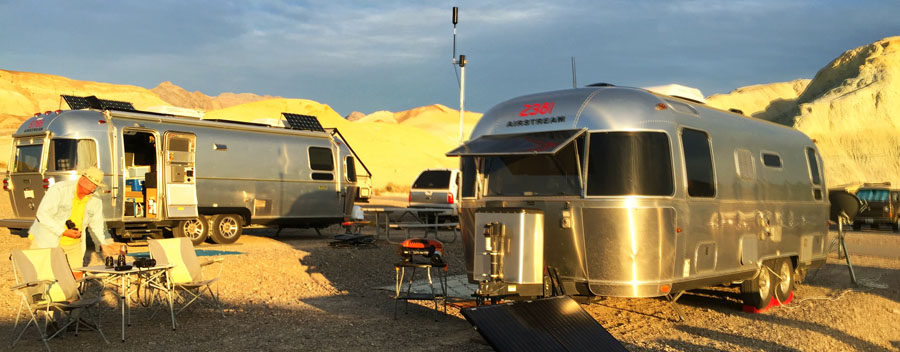
June 2018 - Dry Camping - Preparation and Planning Endurance
Most Airstreams spend their lives traveling from campground [CG] to campground and stay fully hooked up. Taking your adventure to the next level and visiting the extraordinary National Parks or State Parks locations that are exclusively dry camping or just boondocking on Federal land, needs some serious attention to your Airstream systems.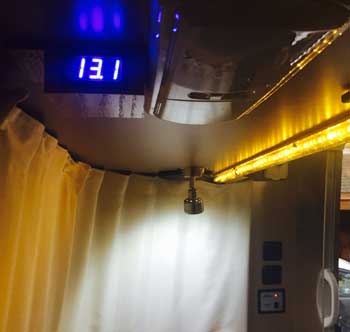 The first and most significant short-term limitation is 12 volt battery power (160 amp/hour capacity with 80 A/H usable), especially in cold weather. Airstreams are woefully unprepared to survive cold nights. Between 30 and 40 F, the furnace will easily drain your Interstate batteries down at 7 to 8 amps per hour to the level of permanent damage, below 12.1 volts. So your choices are to select warmer climate especially if your site is at high altitude, use a generator assuming they are permitted and there are no quiet time restrictions, use a catalytic propane heater inside the Airstream, or add blankets and huddle to preserve body temperature!
The first and most significant short-term limitation is 12 volt battery power (160 amp/hour capacity with 80 A/H usable), especially in cold weather. Airstreams are woefully unprepared to survive cold nights. Between 30 and 40 F, the furnace will easily drain your Interstate batteries down at 7 to 8 amps per hour to the level of permanent damage, below 12.1 volts. So your choices are to select warmer climate especially if your site is at high altitude, use a generator assuming they are permitted and there are no quiet time restrictions, use a catalytic propane heater inside the Airstream, or add blankets and huddle to preserve body temperature! The better approach is to plan ahead by installing solar panels, either factory installed option or robust professional after-market installations such as RVSolar or a portable solar panel that clips to your batteries. Usually such upgrades include AGM or lithium batteries to give you additional amp hours and power longevity. Upgrading to multiple batteries wired in parallel requires consistent brand, capacity, and age. Tricks to extending battery capacity include using higher capacity 6 volt golf cart batteries wired in series, which can give you 300 amp/hour capacity, or using the next size up battery form, which can be fitted by extending the height of the battery box by riveting or bolting an aluminum channel around the top opening.
Healthy batteries will require a full dose of solar energy during the day to bring them back to shape. If you have solar installed on your Airstream roof you are already ahead in the game. We use a 200 watt portable panel that will charge at over 13 volts most of the day and easily add 80 amp/hours. If there is no sun then we fall back to the generator and charge a couple of hours in the morning and another two hours in the evening. We use a Honda EU2000i converted to propane, and it’s very convenient to plug into the Airstream propane outlet, very quiet operation, and powers all our luxury needs like toaster, coffee maker and microwave - but not all at once!
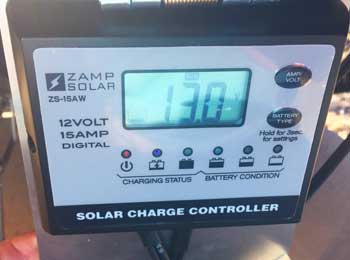 It’s pretty much imperative for the Airstream owner to have an understanding of where your 12 volt power is being used! Most modern Airstreams are fitted with LED lighting, however we discovered our range hood lights were halogen and caused a significant drain until we fitted LED replacements. We also discovered the bass woofer amplifier was permanently wired in, so that was disconnected. The TV antenna amplifier often remains left on. For safety, the propane sniffer alarm stays on permanently, so do the logic boards for the fridge and the water heater. I have found you can unplug the fridge fans overnight without any issues, however we did replace the original installed noisy Rodale fan with two very quiet low current computer fans. We have also been caught out by the external storage compartment lights getting accidentally switched on during travel or by moving items in and out so we disconnected these permanently.
It’s pretty much imperative for the Airstream owner to have an understanding of where your 12 volt power is being used! Most modern Airstreams are fitted with LED lighting, however we discovered our range hood lights were halogen and caused a significant drain until we fitted LED replacements. We also discovered the bass woofer amplifier was permanently wired in, so that was disconnected. The TV antenna amplifier often remains left on. For safety, the propane sniffer alarm stays on permanently, so do the logic boards for the fridge and the water heater. I have found you can unplug the fridge fans overnight without any issues, however we did replace the original installed noisy Rodale fan with two very quiet low current computer fans. We have also been caught out by the external storage compartment lights getting accidentally switched on during travel or by moving items in and out so we disconnected these permanently. Tracking down electrical drains and parasitic use can be detective work. One solution is to insert an ammeter in the circuit and test current use by turning on and off the Airstream systems one by one. Try leaving your Airstream shorepower disconnected in your driveway and see how long it takes to drain down to 50% of full charge at 12.1 volts.
Having replaced the factory installed Interstate batteries with much more resilient AGM’s - Absorbent Glass Mat without liquid - we monitor our voltage with a Digital Volt Meter that permanently displays battery status. Fully charged we can run the LED lighting and fridge, as well as and turn on the inverter at 5 amps per hour for a couple of hours of DVD Video entertainment. As the temperature drops overnight we fire up a Gas Buddy portable catalytic heater, which runs for four hours on one tank. You can switch the tank to a 5 lb or 10 lb tank and extension for complete overnight operation. We open the overhead vents in both the shower and bathroom for ventilation.
As a side note, if your Airstream has been on a dealer lot for an extended period prior to purchase then the factory-installed batteries have probably been compromised. If the batteries do not hold their charge and you are in warranty, you should have the dealer replace them.
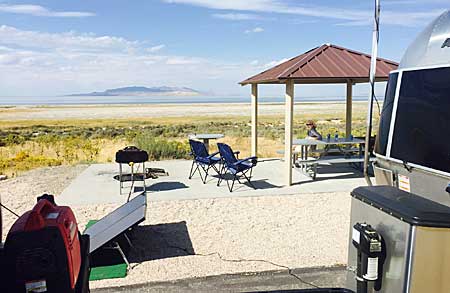 The second dry camping limitation is governed by the water systems, specifically the gray water tank. Our three Airstream tanks are approx 30 gallons each and, even with careful use, invariably with two of us onboard our gray tank is full in 6 to 7 days, black tank in 10 days, fresh water lasts for ten days. With kids on board you can cut those timelines by 50%. This requires discipline and conservation in several ways! Showers need to be navy style with separate short soap and rinse cycles; use the outside shower if CG regulations and weather permit. Dishwashing water can be captured in a plastic sink pan - we use an oil drain pan – and, in most locations, empty the contents outside in the firepit or on plants. The same dishpan is used to capture the first gallon of cold water from the shower before the hot water makes its way from the heater to the showerhead. Typically we ease the load off the gray tank by using lots of sanitized wipes and eating off paper plates. Food residue on real plates is wiped off using paper towel before washing to minimize water use. Toilet use is minimized by short flushes and doubling up the chemical treatment, and we maximize our use of CG and restaurant public facilities as much as possible! We travel with a five gallon plastic water carrier which can be used to top up the fresh water tank, however we always use bottled water for drinking, making coffee or tea and for cooking to minimize any water born infections.
The second dry camping limitation is governed by the water systems, specifically the gray water tank. Our three Airstream tanks are approx 30 gallons each and, even with careful use, invariably with two of us onboard our gray tank is full in 6 to 7 days, black tank in 10 days, fresh water lasts for ten days. With kids on board you can cut those timelines by 50%. This requires discipline and conservation in several ways! Showers need to be navy style with separate short soap and rinse cycles; use the outside shower if CG regulations and weather permit. Dishwashing water can be captured in a plastic sink pan - we use an oil drain pan – and, in most locations, empty the contents outside in the firepit or on plants. The same dishpan is used to capture the first gallon of cold water from the shower before the hot water makes its way from the heater to the showerhead. Typically we ease the load off the gray tank by using lots of sanitized wipes and eating off paper plates. Food residue on real plates is wiped off using paper towel before washing to minimize water use. Toilet use is minimized by short flushes and doubling up the chemical treatment, and we maximize our use of CG and restaurant public facilities as much as possible! We travel with a five gallon plastic water carrier which can be used to top up the fresh water tank, however we always use bottled water for drinking, making coffee or tea and for cooking to minimize any water born infections. As a last resort, just hitch up and find the nearest dump station! The Campendium app has excellent information on this topic! That could take anywhere from an hour to half a day depending on proximity and makes a serious but unavoidable dent in your playtime!
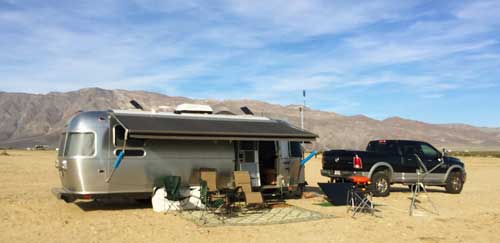 The third limitation is propane gas. We find that using heating, generator, fridge, and water heater, two 30 lbs tank will last a couple of weeks. It is best to get a refill as soon as that first tank expires!
The third limitation is propane gas. We find that using heating, generator, fridge, and water heater, two 30 lbs tank will last a couple of weeks. It is best to get a refill as soon as that first tank expires!
There are other boondocking considerations that require some planning ahead. Familiarize yourself with any Forest Service or BLM regulations, typically there may be a maximum stay permitted. Don’t crowd other campers in your area - after all the pleasure is being in the wide open wilderness so it goes without saying that one should be courteous and make sure that noise pollution from music and generators is minimized. Remember that food and trash may attract wildlife so be prepared for nocturnal visitors by following safe storage practices! Lastly security and theft are a concern, and you should have a game plan and take normal precautions. Cell phone coverage by virtue of your location may be weak or non-existent so you may not be able to rely on that in an emergency.
Dry camping and boondocking provide the closest elements to freedom and enjoyment of the wilderness, seashore or forest, along with the peace and quiet and incredible scenery in off the grid locations. Good preparation is the key, and you can even practice a stress test in your own driveway to build your confidence about your life support systems before stepping out into the wild!
Photo captions: 1- Dry camping at the NPS campground in Death Valley Furnace Creek. The upper CG is a no-generator site so you are totally reliant on solar power. The lower CG permits generators but the view is not as impressive.
2- Digital Voltmeter permanent display over the dinette table allows continuous monitoring of the health of the Airstream electrical system. It is connected into the LED light power supply for ease of installation.
3- Zamp 200 Watt solar panel controller and monitoring station confirms a good supply is being fed to the batteries. Three options for display are volts, amps and amp/hours since connection.
4- Dry camping at Antelope Island State Park UT on the Great Salt Lake Utah. Just make sure you are not in the fly, mosquito and flea season! Lots of space between sites and outstanding views north across the lake. Perfect in the Fall!
5- Boondocking in the Borrego Springs California area on Rockhouse Canyon Road which allows folks to really spread out and offer great views of the Anza-Borrego State Park and mountains. Note full use of all resources including generator, solar panel, satellite TV dish, long range cell phone booster, propane and charcoal grills!
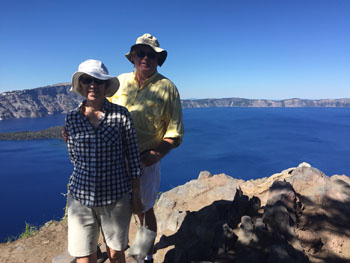 Margaret & David Broad (WBCCI #2381) from Tappahannock Virginia, traveling 8 months of the year since July 2016 in their 2015 Flying Cloud 25 RB. You can email questions or comments to airstream@db26.net Their travel blog is at www.flyingcloud25.blogspot.com and David also publishes an Airstream improvement page at www.facebook.com/airstreamtweaks
Margaret & David Broad (WBCCI #2381) from Tappahannock Virginia, traveling 8 months of the year since July 2016 in their 2015 Flying Cloud 25 RB. You can email questions or comments to airstream@db26.net Their travel blog is at www.flyingcloud25.blogspot.com and David also publishes an Airstream improvement page at www.facebook.com/airstreamtweaks